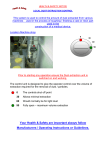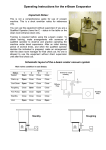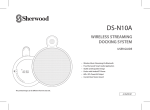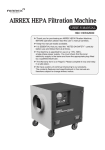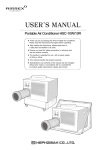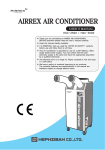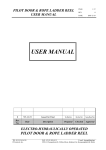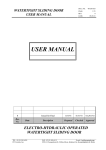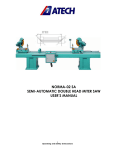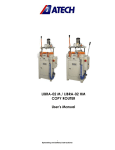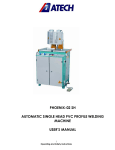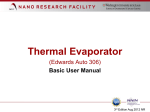Download User Manual of Compact Sputter
Transcript
Compact Sputter-75S User Manual Version 1 Head Office & Factory 175-25 Cheongcheon-Dong 2, Bupyung-Gu, Incheon, 403-853, Rep. Korea Phone: +82-32-508-8060, Fax: +82-32-508-8069 Email: [email protected] Process Equipment Pioneer Compact Sputter-75S Contents 1. Checking points prior to operation 2. Sample loading 3. Pumping 4. Process pressure control 5. Sputtering process 6. Sample unloading 7. Error checking 1 Process Equipment Pioneer Compact Sputter-75S Summary 1) Sputter source Target size : 2in to 3in Target cooling: Water-cooled Shutter: equipped for preventing contamination Applied power: dc/rf 2) Substrate holder Substrate size : max. 4” Substrate heating : max. 300oC 4) Control PLC based touch screen Auto pumping / auto venting Setting power and time 5) Process gas Ar, N2, O2(optional) 6) Utilities CDA pressure: 2.5-5.0 kg/cm2 PCW: 2.5-5.0 kg/cm2 3) Pumping system TMP : 51liter/sec Oil rotary pump : 200liter/min Main valve : optional APC control part : optional Warning light Gas control Pumping control Vacuum control Gauge control Power control Figure 1. Control panel 2 Process Equipment Pioneer 1. Checking points prior to operation Compact Sputter-75S 1. Checking points prior to operation 1-1. Air pressure and water pressure ▶ Because air pressure is essential for valve operation, its supply state must be checked before system operation. Air condition: CDA (Clean Dry Air) Air pressure range: 2.5- 5kg/cm2 ▶ Because cooling water is essential for dissipating heat from sputter target and for cooling TMP, cooling water pressure, temperature and flow rate must be controlled in an appropriate range. Cooling water temperature: <20oC Cooling water pressure: 1-2kg/cm2 Cooling water flow rate: >20l/min ▶ The utilities for air and water pressures are prepared by user. But the connection ports are equipped on the sputter system by supplier. Connection port for air : ¼” LOK type Connection port for water: 3/8” LOK type 1-2. Checking of power connection ▶ It is essential that power source is well-connected and the main electric distribution board and the breaker in system are positioned in turn-on. Electricity: 220V, single phase, 15A ▶ Electrical grounds in system must be independently secured and it is supplied by user. ▶ Power source connector must be externally connected through main breaker. 1-3. Process gas connections ▶ Argon and nitrogen gases are provided as main gases and their remaining amounts in bombes must be checked periodically for a continuous sputtering process. The process gases are prepared by users. Gas pressure: >1.2kg/cm2 Gas line: ¼” stainless steel (electro-polished) Gas line finishing: ¼” LOK 3 Process Equipment Pioneer 2. Sample loading Compact Sputter-75S 2. Sample loading TMP off & Breaking vacuum Close / chamber door Sample loading (on substrate holder) Open chamber door Pumping 2-1. Manually vacuum-breaking ▶ If V/V is clicked on touch screen (red color rectangle), vacuum is sequentially being broken. At this time R/V, G/M and M/V must be kept in closed states. But safety interlock system prevents V/V from being opened under the open state of R/V and G/M. During vacuum breaking, TMP must be shut down, but it is acceptable for rotary pump to work with roughing valve close. Figure 2. Breaking vacuum manually 2-2. Manually vacuum-breaking Figure 3. Gas introduction to chamber Figure 4. Configurations for pumping 2-3. Automatically vacuum-breaking ▶ If auto vent (in yellow rectangle) is touched, vacuum breaking is automatically processed through a proper sequence. 4 Figure 5. Automatic pumping Process Equipment Pioneer 3. Pumping Compact Sputter-75S 3. Pumping ▶ Pumping is processed in the order of rough vacuum pumping and high vacuum pumping as follows. All of these operation are done on touch screen. Open/close chamber door Open roughing valve Pumping mechanical pump Open foreline valve Pumping TMP after 5E-2 Torr Close roughing valve 3-1. Manually Pumping Pumping mechanical pump Open roughing valve Open foreline valve Pumping TMP after 5E-2 Torr Close roughing valve Figure 6. Pumping line 3-2. Automatically pumping ▶ Automatic pumping is processed by touching auto pumping menu (in yellow rectangle) on touch screen. Figure 7. Automatic pumping control panel 5 Process Equipment Pioneer 4. Process pressure control Compact Sputter-75S 4. Process pressure control ▶ Process pressure is controlled by the combination with process gas, and low vacuum pump. The process pressure is set according to following flow chart sequence. Introduce gas Setting pressure reached Set process pressure Sputtering process 4-1. Manual process pressure control ▶ Vacuum-related menu is shown on touch panel as follows. Set gas flow rate Open G/M (gas main valve) Open valve of Ar out/O2 out Check flow rate Figure 8. Schematic of gas introduction line Check pressure reached 6 Process Equipment Pioneer 5. Sputtering process Compact Sputter-75S 5. Sputtering process ▶ Sputtering is processed through plasma discharge by applying power on cathode after process pressure is set. Control process pressure Apply power on sputter cathode Sputtering process 5-1. Target to substrate distance control ▶ Target to substrate distance is manually controlled over the range of 60mm to 100mm. 5-2. Sputtering process ▶ Sputtering is processed by setting process time and power in menu enclosed with red rectangle, as shown in following figure.9 Figure 9. Sputtering power control panel 7 Process Equipment Pioneer 6. Sample unloading & 7. Error checking Compact Sputter-75S 6. Sample unloading ▶ Processed sample is manually unloaded from substrate holder after coating sample as shown in following flow chart. Break vacuum Unload coated sample Open chamber door Close chamber door 7. Error checking ▶ The errors occurred in system are monitored and displayed with their messages such as cause, occurrence frequency, time and date, etc. As icon in touch screen is clicked the pictures of error message or main control are repeatedly displayed. Figure. 10 Control part ions 8 Figure 11. Error message picture Process Equipment Pioneer









